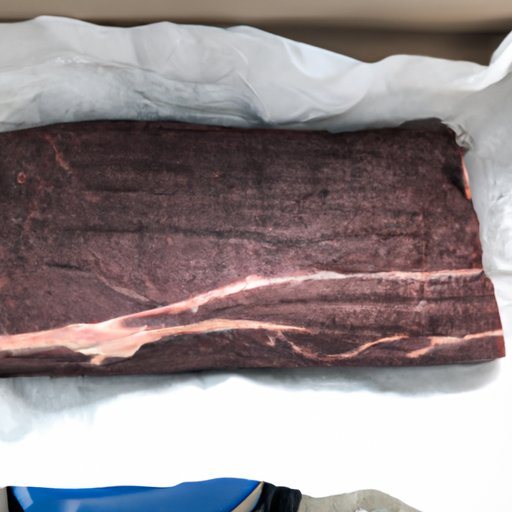
Introduction
BBQ enthusiasts are always searching for the best ways to cook and serve a succulent brisket. One technique that has gained popularity in recent years is wrapping brisket in butcher paper. This method helps retain moisture, flavor, and texture, creating a juicy and delicious result. In this article, we’ll explore the advantages of wrapping brisket in butcher paper, step-by-step instructions, and tips and tricks to master this technique for the perfect BBQ.
The Advantages of Wrapping Brisket in Butcher Paper and How to Do It Right
Butcher paper is a popular choice among pitmasters because it has a unique ability to hold in moisture while still allowing the meat to breathe. This creates an environment where the brisket can cook evenly and retain that juicy tenderness that everyone craves. Additionally, wrapping in butcher paper will form a natural bark on the meat, which is a highly sought after trait in BBQ circles.
When it comes to wrapping brisket, there are a few key things to keep in mind. First, make sure the brisket reaches an internal temperature of 160-170°F before wrapping. This will give the meat time to form a nice crust and set the bark. To wrap, lay the butcher paper flat on a clean work surface and place the brisket in the center. Fold the paper over the brisket, tucking in the edges tightly to enclose the meat. The paper should form a snug, tight package around the brisket.
Step-by-Step Instructions: How to Properly Wrap Brisket in Butcher Paper
Let’s dive into the step-by-step process of wrapping brisket in butcher paper:
- Preheat your smoker or oven to 225°F.
- Remove the brisket from its packaging and trim any excess fat. Then, season the brisket with your favorite BBQ dry rub.
- Place the brisket on the smoker or oven, fat cap side up, and let it cook until it reaches an internal temperature of 160-170°F.
- Take a large sheet of butcher paper, about double the size of the brisket, and lay it flat on your work surface.
- Place the brisket in the center of the paper with the fat cap facing up. Fold one side of the paper over the brisket, tucking it tightly under the meat.
- Next, bring the two ends of the paper together over the top of the brisket and fold them down tightly.
- Finally, take the remaining side of the paper and fold it over the brisket, sealing it tightly.
- Place the wrapped brisket back on the smoker or oven and cook until it reaches an internal temperature of 200-205°F.
The Ultimate Brisket Wrapping Hack: Butcher Paper Guide for Perfect Brisket
If you want a hack that will take your brisket to the next level, try crumpling up the butcher paper before wrapping. This creates crevices and wrinkles that trap air and steam, forming a better seal around the meat. As a result, you’ll get a more pronounced smoky flavor and a beautiful bark that everyone will rave about. So next time you wrap your brisket, try crumpling the paper first and see the difference for yourself!
A Beginner’s Guide to Wrapping Brisket in Butcher Paper for Pitmasters
If you’re new to wrapping brisket in butcher paper, don’t worry! Here are some tips to help you get started:
- Choose high-quality butcher paper that is unbleached, unwaxed, and untreated. This will ensure that no harmful chemicals are transferred to your meat.
- Make sure the brisket has a nice crust before wrapping. This will help preserve the bark and keep it intact during the wrap.
- Tightly wrap the brisket in the paper to ensure even cooking and prevent drying out.
- Place the wrapped brisket back on the smoker or oven with the seam side down to prevent leaking.
- Don’t rush the wrapping process. Take your time and make sure the paper is tight and secure around the brisket.
How to Keep Your Brisket Moist and Juicy with Butcher Paper Wraps
The key to juicy brisket is retaining moisture during the cooking process. Wrapping brisket in butcher paper helps to create a humid environment that will keep the meat moist and tender. To ensure your brisket stays juicy, be sure to follow these tips:
- Dry your brisket with a paper towel before seasoning. This helps the rub stick better and promotes better browning.
- Place a drip pan filled with water under the brisket to create steam in the cooking chamber.
- Wrap the brisket in butcher paper once it has developed a nice bark and has reached an internal temperature of around 160-170°F.
- Make sure the paper is tightly wrapped to prevent any air from escaping. This will help the brisket retain moisture and flavor.
- Let the brisket rest for at least 30 minutes after cooking to allow the juices to redistribute throughout the meat.
Mastering the Art of Brisket Wrapping: Butcher Paper Techniques for Perfect BBQ
Wrapping brisket in butcher paper is an art form that takes practice to perfect. Here are some advanced techniques to help you become a master of brisket wrapping:
- Use two layers of paper for extra protection and insulation.
- Cut a small hole in the top of the paper to release excess steam and prevent overcooking.
- Apply a light spritz of apple juice or other liquid before wrapping to add flavor and moisture.
- Wrap the brisket in pink, butcher paper to give it a unique, authentic look, and feel.
- Use a probe thermometer to monitor the internal temperature while the brisket is wrapped.
Conclusion
Wrapping brisket in butcher paper is a popular and effective technique for creating a juicy and flavorful result. Whether you’re a seasoned pitmaster or a beginner, following these tips and tricks will help you to master the art of wrapping brisket in butcher paper. Remember to choose high-quality, unbleached paper, and take your time when wrapping to ensure a tight and secure seal.




